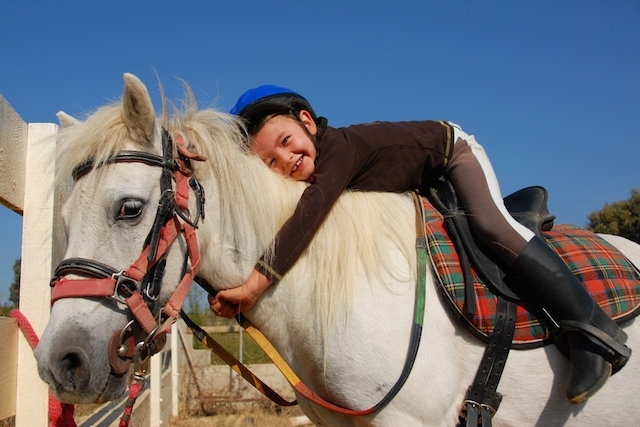Equotherapy is a therapeutic method that uses a cavalry in an interdisciplinary approach to health, education, and equalization, seeking or biopsy-free development of people with a deficit and/or special needs. Equotherapy employs a horse as an agent to promote physical and psychic levels. It is necessary to participate in the body of the body, to contribute, to assume, the development of the muscular force, relaxation, knowledge of the body’s own work, and the experience of motor coordination and equilibrium.
The benefits of hippotherapy:
- Pelvic mobilization, lumbar spine, and hip joints.
- Improved balance and posture.
- Develops coordination of movements between trunk, limbs, and vision.
- Stimulates tactile, visual, auditory, olfactory sensitivity, improving sensory-motor integration.
Areas of Application of Hippotherapy:
- Health – physical and or mental rehabilitation.
- Education – Educational Needs.
- Social – behavioral disorders.
The interaction with the horse, including the first contacts, the preliminary care, the act of riding, and the final handling, also develops new forms of socialization, self-confidence, and self-esteem.
Riding Therapy Session Approaching Phase
Practitioner’s contact with the horse.
You have to be progressive and patient.
Discovery Phase
Overcome the fear of the Horse.
Horse Exploration – head, muzzle, mouth, ears, tail, paws, etc …
Exploration of the practitioner’s Sensitivity (coat, smell, etc …).
Beginning of the practitioner’s bond.
Educational Phase
The practitioner performs the specific activities for each case.
The practitioner receives all sensitive and psychomotor information
Rupture Phase
Separation from your horse friend.
If necessary, follow up to the stall, remove the harness to feed it, pet it.
The horse and its contribution as a therapeutic tool
The first manifestation when a human being is on horseback is the tonic adjustment. In fact, the horse is never completely still. The change of support of the legs, the displacement of the head when looking to the sides, the flexions of the spine, the lowering and stretching of the neck, etc., impose on the rider an adjustment in his muscular behavior, in order to respond to the imbalances caused by these movements . There are several researches on the movements of the horse’s back and its consequences for the rider, among the researchers are Dr. Hubert Lallery (France) and the ballet team, in Switzerland. The tonic adjustment, automatic adaptation movement, becomes rhythmic, with the displacement of the horse in step. Adaptation, to the rhythmic, is one of the masterpieces of hippotherapy. The horse’s pace, being regular, determines a rhythm that becomes a momentum for the rider. The rhythm of the horse in step is located at a frequency that can vary between 40 and 78 beats per minute (very elongated and very short step) that will have therapeutic use, according to the pathological need of the practitioner.
The rhythmic tonic adjustment determines an osteo – articular mobilization that facilitates a large number of proprioceptive information. The proprioceptive information that comes from the articular, muscular, periarticular and tendinous regions provokes, in the sitting position on the horse, new information, quite different from the usual ones that are provided to the person in the standing position, on the feet. This new proprioceptive information, determined by the horse ‘s step, allows the creation of neuro – muscular schemes (Dr. Hubert lallery – Cheval Connexin magazine nº 8, Oct. 88 – Paris). The adaptation of the rider to the rhythm of the horse’s step requires simultaneous contraction and relaxation of the agonist muscles.
On the other hand, the effect of the three-dimensional movement of the horse’s back, described and studied for the first time by the German doctors SAMUEL THEODOR QUELMAZ, in addition to the multidirectional determines an action, produced by the movement of the horse and the pace of its step, which make the horse a kinesiotherapeutic instrument. Each complete step of the horse has patterns similar to those of human walking: it imposes a displacement of the pelvic recitation of the order of 5 cm in the vertical, horizontal and sagittal planes and a rotation of 8 degrees to one side and to the other. The horse, when moving, requires tonic adjustments from the rider to adapt its balance to each movement. Each step of the horse produces from 1 (one) to 1.25 (one twenty-five) movements per second. In 30 minutes of work, the rider performs from 1800 (one thousand and eight hundred) to 2,250 (two thousand, two hundred and fifty) tonic adjustments. The displacements of the pelvic girdle produce vibrations in the osteo-articular regions that are transmitted to the brain, via the spinal cord, with the frequency of 180 oscillations per minute, which has already been pointed out as being the most suitable for health.
Conjugated Movements between Practitioners and the Horse
Guiding the horse to put a long, straight line brings the practitioner bending movements and extension.
Facilitating trunk control, pelvis movements back and forth, with transitions
between strong and weak impulses, lengthening and shortening the pace of the walking-stop-walking horse.
Movement in the frontal plane helps the lateral flexions of the practitioner, stretching and shortening the musculature, the trunk, and displacement of weight.
Curved horse – increased pelvic rotation movements.
Horse in a circle – practitioner leans towards the outside of the curve (centrifugal force impulse).
Discover more from Pilates All Ages
Subscribe to get the latest posts sent to your email.
